Geology Reference
In-Depth Information
Sulphuric acid was generated as a result of the geological materials
present and this acid polluted local stream courses. Carbon dioxide,
because it is heavier than air, collected in underground inspection
chambers and four workers died as a consequence. The various
chemical reactions and processes are discussed in detail by Pye &
Miller (1990). The lesson is that potential chemical reactions
should be considered for any project. Other examples are given in
7.3.2 Strength and abrasivity of flint and chert: gas
storage caverns Killingholme, Humberside, UK
Another example of a material-scale factor that should have been
anticipated is shown in
Figure 7.2,
which shows a cavern in chalk
under construction for the storage of lique
ed gas beneath South
Killingholme, Yorkshire. The roadheader pictured had been speci
ed
for the excavation of the caverns and had been dismantled and lowered
down a narrow shaft for this purpose. Excavation by the road header
proved impractical economically, because of wear caused by the pre-
sence of bands of extremely strong and abrasive
flints and chert in the
chalk. Blasting had to be used instead to excavate the caverns (Anon,
1985). Perhaps the presence of bands of
flint might have been antici-
pated in the chalk, even if it had not been logged during site-speci
c
drilling (probably due to inadequate sampling).
7.3.3 Abrasivity: TBM Singapore
Shirlaw
et al
. (2000) provide examples of the high abrasion that can
result from high quartz content in soils, weathered and fresh rock
during tunnelling. As part of the construction of the North East Line
of the Mass Rapid Transit in Singapore, two tunnels were driven from
Figure 7.2
Killingholme LNG
caverns under
construction. The
roadheader is being
used to trim blasted
caverns rather than
excavate them as
had been the
original intention.

